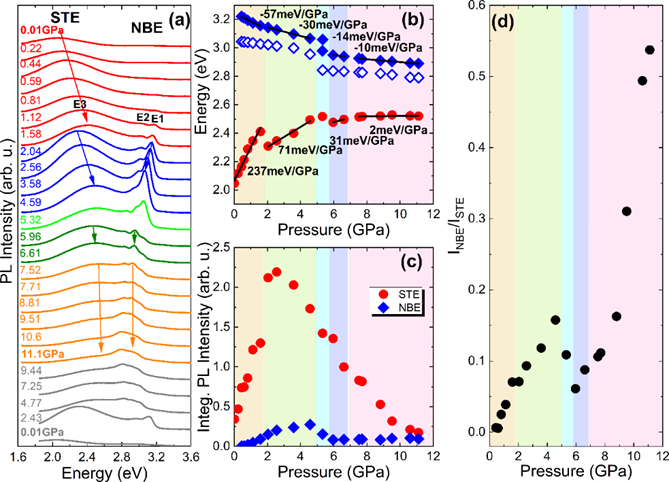Pressure-Induced Detrapping from Self-Trapped Excitons to Free Excitons Toward Enhanced Emission and Piezochromism in Ruddlesden-Popper (110)-Oriented Perovskite
Title: Pressure-Induced Detrapping from Self-Trapped Excitons to Free Excitons Toward Enhanced Emission and Piezochromism in Ruddlesden-Popper (110)-Oriented Perovskite
Authors: M. Mączka, S. Sobczak, K. Roszak, D. L. M. Vasconcelos, F. Dybała, A. P. Herman, R. Kudrawiec, A. Katrusiak, P. T. C. Freire
Journal: ACS Appl. Mater. Interfaces
Two-dimensional (2D) lead halide perovskites are emerging as excellent materials for optoelectronic applications including light-emitting diodes and photodetectors, owing to their efficient excitonic emission originating from both self-trapped excitons (STEs) and free excitons (FEs). Recently, many efforts have been focused on enhancing the emission intensity, modulating the dominant emission mechanism, and establishing direct correlations between optical properties and underlying structural motifs. In their recent article, prof. Mączka together with collaborators from a few Universities reports discovery of a pressure-induced enhancement of STEs and FEs emission in the topology of the (110)-oriented Ruddlesden–Popper perovskite ACE2PbBr4 (ACE = acetamidinium), accompanied by the rare phenomenon of the reversible detrapping process from STEs to FEs under compression. In situ single-crystal X-ray diffraction and Raman spectroscopy revealed that these emission changes and pronounced piezochromism arise from the pressure-induced reduction of lead-bromide octahedral distortion, contrasting with the increased octahedral distortion reported in most previous studies on lead halide perovskites, and the reduction of electron confinement in the direction of the corrugated structure and changes in amine-framework interactions, as well as pressure-induced phase transitions occurring near 2, 5, 5.9 and 6.7 GPa.
Overall, this work provides a strategy to achieve efficient and strongly tunable emission by pressure-induced structural changes in layered perovskites and highlights the importance of organic cation in the regulation of the mechanical behavior, polymorphism, and PL properties of (110)-oriented perovskites.

Highlights:
- High-pressure studies are reported for the first time for a corrugated Ruddlesden-Popper perovskite
- Pressure enhances emission intensity and leads to transfer from the STEs to FEs
- The studied compound exhibits pronounced piezochromism and undergoes 4 phase transitions
- The origin of unusual optical properties has been explained based on X-ray diffraction and Raman studies
See also
- The Institute
- General information
- Employees
- News
- Scientific News
- Gender equality plan
- Address and contact data
- Research
- Research profile
- List of publications
- List of projects
- International cooperation
- Information in BIP
- Scientific Council
- Organizational structure
- GDPR


